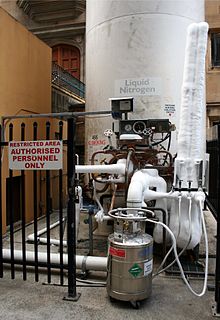
Back Laetemperatuurfisika Afrikaans تبريد عميق Arabic Kriogen proses Azerbaijani Криогеника Bulgarian হিমবিজ্ঞান Bengali/Bangla Criogènia Catalan Kryogenika Czech Cryogeneg Welsh Kryotechnik German Κρυογενετική Greek



In physics, cryogenics is the production and behaviour of materials at very low temperatures.
The 13th International Institute of Refrigeration's (IIR) International Congress of Refrigeration (held in Washington DC in 1971) endorsed a universal definition of "cryogenics" and "cryogenic" by accepting a threshold of 120 K (−153 °C) to distinguish these terms from the conventional refrigeration.[1][2][3][4] This is a logical dividing line, since the normal boiling points of the so-called permanent gases (such as helium, hydrogen, neon, nitrogen, oxygen, and normal air) lie below 120 K, while the Freon refrigerants, hydrocarbons, and other common refrigerants have boiling points above 120 K.[5][6]
Discovery of superconducting materials with critical temperatures significantly above the boiling point of nitrogen has provided new interest in reliable, low cost methods of producing high temperature cryogenic refrigeration. The term "high temperature cryogenic" describes temperatures ranging from above the boiling point of liquid nitrogen, −195.79 °C (77.36 K; −320.42 °F), up to −50 °C (223 K; −58 °F).[7] The discovery of superconductive properties is first attributed to Heike Kamerlingh Onnes on July 10, 1908. The discovery came after the ability to reach a temperature of 2 K. These first superconductive properties were observed in mercury at a temperature of 4.2 K.[8]
Cryogenicists use the Kelvin or Rankine temperature scale, both of which measure from absolute zero, rather than more usual scales such as Celsius which measures from the freezing point of water at sea level[9][10] or Fahrenheit which measures from the freezing point of a particular brine solution at sea level.[11][12]
- ^ International Dictionary of Refrigeration, http://dictionary.iifiir.org/search.php Archived 2019-10-01 at the Wayback Machine
- ^ ASHRAE Terminology, https://www.ashrae.org/technical-resources/free-resources/ashrae-terminology
- ^ "Cryogenics is usually defined as the science and technology dealing with temperatures less than about 120 K [4,5], although this review does not adhere to a strict 120 K definition." K.D. Timmerhaus, R. Reed. Cryogenic Engineering: Fifty Years of Progress. Springer Science+Business Media LLC (2007), chapter: 1.2 The Beginning of Cryogenics, p. 7
- ^ "About Cryogenics".
In terms of the Kelvin scale the cryogenic region is often considered to be that below approximately 120 K (-153 C).
- ^ "DICHLORODIFLUOROMETHANE at Pubchem".
- ^ "PROPANE at Pubchem".
- ^ J. M. Nash, 1991, "Vortex Expansion Devices for High Temperature Cryogenics", Proc. of the 26th Intersociety Energy Conversion Engineering Conference, Vol. 4, pp. 521–525.
- ^ Radebaugh, R. (2007), Timmerhaus, Klaus D.; Reed, Richard P. (eds.), "Historical Summary of Cryogenic Activity Prior to 1950", Cryogenic Engineering, International Cryogenics Monograph Series, New York, NY: Springer, pp. 3–27, Bibcode:2007cren.book....3R, doi:10.1007/0-387-46896-x_1, ISBN 978-0-387-46896-9
- ^ Celsius, Anders (1742) "Observationer om twänne beständiga grader på en thermometer" (Observations about two stable degrees on a thermometer), Kungliga Svenska Vetenskapsakademiens Handlingar (Proceedings of the Royal Swedish Academy of Sciences), 3: 171–180 and Fig. 1.
- ^ Don Rittner; Ronald A. Bailey (2005): Encyclopedia of Chemistry. Facts On File, Manhattan, New York City. p. 43.
- ^ Fahrenheit temperature scale, Encyclopædia Britannica Online. 25 September 2015
- ^ "Fahrenheit: Facts, History & Conversion Formulas". Live Science. Retrieved 2018-02-09.
© MMXXIII Rich X Search. We shall prevail. All rights reserved. Rich X Search